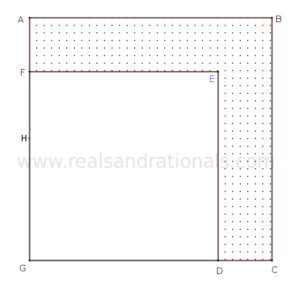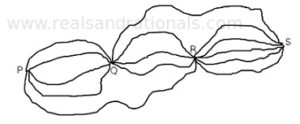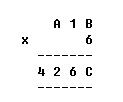Problem set 1
Problem set 2
Problem set 3
Problem set 4
Problem set 5
Problem set 6
Problem set 7
Problem set 8
Problem set 9
Problem set 10
Problem set 11
Problem set 12
Problem set 13
Problem set 14
Problem set 15
- If a natural number
leaves a remainder of
when divided by
, what remainder does the number
leave when divided by
?
- In the repeating decimal,
, what is the
rd digit after the decimal point?
- What is the value of:
?
. What whole number value can replace
?
- I distribute
grapes into
bowls. Each bowl has a different number of grapes, and no bowl has a number of grapes that is a multiple of
. What is the greatest number of grapes that can be in a bowl?
- You get
days of summer holidays. What is the maximum number of Thursdays that can be there during the holidays?
- From a bag of candies, Don takes half the candies. Alice takes half of what are left after Don. Jim takes half of what are left after Don and Alice. Anita takes half of what are left after Don, Alice and Jim. Finally, Rachel takes half of what are left. In the end, three candies are left in the bag. How many candies were in the bag to start with?
- Oliver has twice as many brothers as he has sisters. His sister Rita has three times as many brothers as she has sisters. How many boys and girls (excluding parents) are there in all in the family?
- In the following figure,
and
are squares each with a counting number as the length of its side. The area of the dotted region is
square units.
is the midpoint of the side
. What is the length of
?

- How many different paths are there to go from point
to point
such that points
and
are visited once and only once?

- How many numbers between
and
can be written as a product of an even number times an even number?
- The number
can be written as a product of prime numbers as
. How many different factors does
have?
- Sylvia has
candies more than Lydia. Sylvia gives
of her candies to Lydia. Now, how many more candies does Lydia have than Sylvia?
- The number of stamps in Raman’s stamp collection is between
and
. He arranges the stamps in groups of
, and he finds that two stamps are left over after he forms the groups. He arranges them in groups of
, and he finds that he has one stamp left over. He arranges them in groups of
, and he finds that there are no stamps left over after he forms the groups. How many stamps does Raman have in his collection?
represents a three digit number key. Following are clues to decode the key:
- In the arrangement
, two digits are incorrect, one digit is correct. The correct digit is however in the wrong place.
- In the arrangement
, two digits are incorrect, one digit is correct. And, the correct digit is in the correct place.
- In the arrangement
, two digits are correct, one digit is incorrect. And, both the correct digits are in the wrong places.
What is the three digit number key?
- In the arrangement
- Jay has two boxes. The first box holds numbers
, while the second box holds numbers
. He does the following with the numbers:
- he pairs up each number in the first box to a number in the second box. For example, he could pair up the numbers as
. Note that each of the numbers is used only once in forming the pairs.
- Once he forms the pairs, he multiplies the numbers in each pair. Thus, in the above example, he does
to get
,
to get
and so on.
- he then adds the four resultant numbers to get one final number.
What is smallest number he could get by doing the above steps using the numbers he has?
- he pairs up each number in the first box to a number in the second box. For example, he could pair up the numbers as
- In a sequence of numbers, the first number is
and the third number is
. The sequence is such that the sum of any three consecutive numbers is
. What is the thousandth number of the sequence?
- A train covers a distance of
miles in
sec. How many miles does the train cover in
hours?
- If
, what are all the possible values of
?
- In the following multiplication, different letters represent different digits. What is the value of the three digit number
?

- Mr.Sun, Mr.Mercury, Mr.Earth and Mr.Neptune are strolling in a garden. Mr.Sun says he is older than Mr.Earth. Mr.Earth says he is older than Mr.Mercury. Mr.Mercury says he is older than Mr.Earth. Mr.Neptune says he is older than Mr.Sun, but younger than Mr.Mercury. All but one are saying the truth. Who is lying?
- To paint the surface of a cube of side
cm,
ml of paint is required. Ten such unpainted cubes are taken, stacked on top of each other and glued together. How much paint is required to paint the surface of this new structure?
- At exactly 3:30PM, Will started hiking up a trail while Arthur started hiking down the same trail. By 4:30PM, Will had hiked up two-thirds of the trail, while Arthur had hiked down five-sixths of the trail. What is the distance between Arthur and Will at 4:30PM as a fraction of the trail length?
- A whole number
when divided by each of
and
leaves a remainder
each time. What is the smallest possible value for
?
- The least common multiple (LCM) of two numbers is
. One of the numbers is
. What is the total number of possibilities for the other number?
- The product of digits of a four digit number is
. What is the biggest possible value for the four digit number?
- Rubik’s cubes of dimensions
are being packed in a rectangular box of dimensions
. What is the most number of Rubik’s cubes that may be packed in the box?
- If
, what is the value of
?
- What is the ones place of
?
- A supervisor has five tasks to be completed, and he has two workers to do the tasks. The five tasks take 4 hours, 5 hours, 6 hours, 10 hours, 12 hours respectively to complete by either of the workers. Assuming the supervisor does not want to split a task between the two workers, what is the shortest time in which he can get all the tasks completed?
- What is the number of factors of
?
dozen apples and
dozen oranges together cost
.
dozen apples and
dozen oranges together cost
. How much do
dozen apples and
dozen oranges together cost? How much does
dozen apples cost?
- Carlos spent
th of the money he had to buy bread. Of the remaining, he spent
th on milk. Of the remaining, he spent
rd on eggs. Finally, he had
left. How much money did he have to start with?
- Ralph’s average score in final exams across all but one of his subjects was
. He now got his score in the last subject as
. This pulled down the average to
. How many subjects did Ralph have in all?
- A bus travels
miles in
min
sec. How much distance does the bus travel in
hour?
- An ant is at the number
on the clock. And, the time is exactly
PM now. As the seconds hand moves, the ant moves on the rim of the clock along with the seconds hand. The ant gets tired after moving for
seconds. It starts moving again when the seconds hand makes one complete circle and comes back to the ant. The ant moves again for
seconds, and it takes a break again until the seconds hand makes another complete circle and comes back to it. This same pattern goes on for several minutes. What is the time when the ant first gets to the number
on the clock?
- A number is chosen randomly from all two digit numbers. What is the probability that the number is divisible by
?
- Mr.Rumpelstiltskin is between
and
years old. When his age is divided by
, it leaves a reminder of
, and when his age is divided by
, it leaves a reminder of
. What is Mr. Rumpelstiltskin’s age?
- The number
is defined to be
. For example,
. What is the value of
?
- What is the smallest number that leaves a remainder
when divided by
, a remainder
when divided by
, a remainder
when divided by
, and a remainder
when divided by
?
represents a digit, and the number
is divisible by
. What is the value of
?
. What is the biggest value of
such that
is a factor of
?
- Name the smallest and biggest of the following:
given that
- Name the smallest and biggest of the following:
given that
- Name the smallest and biggest of the following:
given that
are three numbers such that
. The average of the three numbers is
more than
. If
is
more than
, how much more than
is
?
- Michael, Ryan, Kevin, David and Sam are standing on a straight line. Ryan is
feet away from Michael, Kevin is
feet away from Ryan, David is
feet away from Kevin, Sam is
feet away from David and Michael is
feet away from Sam. Which two persons are closest in distance to each other, and how far apart (in feet) are they?
- We call a number super-duper even (for fun) if it is the sum of six consecutive even numbers. What is the smallest super-duper even number that is bigger than
?
- What is the value of
?
- The average of a certain group of numbers is
. When the number
is added to the group, the average decreases by
. How many numbers (including the new number added) are there in the group?
- How many numbers between
and
leave a remainder of
when divided by
and
?
- A defective clock runs slow, and regularly loses a few seconds every minute. On a particular day, when the correct time was
AM, the defective clock showed
AM, and when the correct time on the same day was
PM, the defective clock showed
AM. What time would the defective clock show when the actual time on the same day is
PM?
- In a room, there are
kids wearing red shirts,
kids wearing green shirts and
kids wearing blue shirts. I call one kid out every minute for
minutes. What is the minimum number of kids wearing red shirts that I know will come out?
- Two standard dice are rolled. What is the probability that the sum of the two numbers on top of the dice is
?
- Heather, Melody and Christiana are blindfolded. They are each offered three ribbons of colors red, blue and green. What is the probability that they pick three different colors?
- In the previous problem, what is the probability that Heather picks a color different from what Melody and Christiana pick?
- There are
boy students and a certain number of girl students in a room. Each student is assigned a number. I have to pick one of the numbers assigned to the students at random (blindfolded), and a student comes out if his or her number gets picked. If the probability that a girl student comes out is
, what is the total number of students in the room?
- What is the ones’ place of
?
- What is the value of
?
- What is the value of
?
- If
and
is a counting number, what is the value of
?
- What is the ones’ place of
?
- If
pomogs make
tomogs and
domogs make
pomogs, how many tomogs make a domog?
- Two counting numbers add up to
. What is the biggest possible number you could get out of multiplying them?
and
are four consecutive counting numbers with
. Also,
and
are divisible by
and
respectively. What is the smallest possible value of
?
- If
and
represent digits (not necessarily all different), what is the biggest possible 5-digit number of the form
that is odd and divisible by
?
- What is the ones’ place of
?
- If
and
are natural numbers such that
, what is the smallest number that
can be?